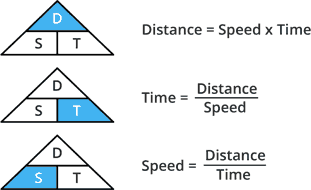Speed measurement with ultrasonic sensor HC-SR04 (C++)
This tutorial guides you through calculating a relative velocity by using the distance measurement of the HC-SR04 sensor over the time.
In order to be able to measure a speed at all, we must first be able to measure a distance to an object. Ultimately, the ultrasonic sensor can do no more. Therefore, first read Distance measurement with ultrasonic sensor HC-SR04 (C++).
Calculating the speed
Let's take another closer look at the triangle from the previous chapter:

So we need
Speed = Distance / Time
However, we do not want to go to the speed of sound now and check whether there is a deviation here.
I will show you how to measure the speed of movement of an object using this sensor. For that purpose we need to take two distance measurements in a short time apart and we have:
distance2 - distance1 = distance speed at a given time
If we make the measurements in a time period of 1 second, then we get the speed of movement of the object in cm/s.
When the object is moving in the opposite direction, the speed represented on the display has a negative sign.
Programming the speed measurement
We change our code from the previous example as follows:
#include <iostream>
#include <wiringPi.h>
#include "libHCSR04.h"
HCSR04::HCSR04(){}
void HCSR04::init(int trigger, int echo)
{
this->trigger=trigger;
this->echo=echo;
pinMode(trigger, OUTPUT);
pinMode(echo, INPUT);
digitalWrite(trigger, LOW);
delay(500);
}
double HCSR04::distance(int timeout)
{
delay(10);
digitalWrite(trigger, HIGH);
delayMicroseconds(10);
digitalWrite(trigger, LOW);
now=micros();
while (digitalRead(echo) == LOW && micros()-now<timeout);
recordPulseLength();
travelTimeUsec = endTimeUsec - startTimeUsec;
distanceMeters = 100*((travelTimeUsec/1000000.0)*340.29)/2;
return distanceMeters;
}
double HCSR04::speed(int timeout)
{
// calls the distance() function above
distance1 = this->distance(timeout)
// giving a time gap of 1 sec
delay(1000);
// calls the distance() function above a second time
distance2 = this->distance(timeout)
// formula change in distance divided by change in time
// as the time gap is 1 sec we divide it by 1.
speed = (distance2 - distance1)/1.0
return speed
}
void HCSR04::recordPulseLength()
{
startTimeUsec = micros();
while ( digitalRead(echo) == HIGH );
endTimeUsec = micros();
}The header file looks now like this:
#ifndef DEF_SONAR
#define DEF_SONAR
class HCSR04
{
public:
HCSR04();
void init(int trigger, int echo);
double distance(int timeout);
double speed(int timeout);
private:
void recordPulseLength();
int trigger;
int echo;
volatile long startTimeUsec;
volatile long endTimeUsec;
double distanceMeters;
long travelTimeUsec;
long now;
};
#endifAnd at least you can test it with following code:
#include <iostream>
#include <wiringPi.h>
#include "libHCSR04.h"
using namespace std;
int trigger = 1;
int echo = 5;
int main()
{
if (wiringPiSetup() == -1)
return -1;
HCSR04 ultrasonic;
ultrasonic.init(trigger, echo);
while(1){
cout << "Speed is " << ultrasonic.speed(1000000) << " cm/s." << endl;
}
}Now that we know what we can measure with the HC-SR04 and how, we can write our driver and wrap it in ROS in the next chapter. Please read for this Writing your HC-SR04 driver (C++).







